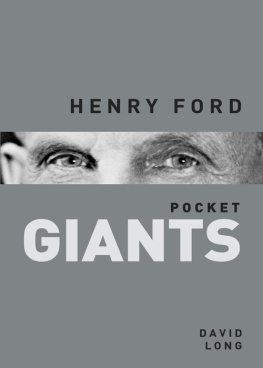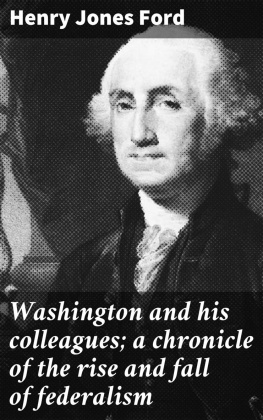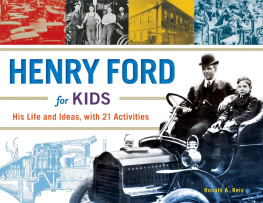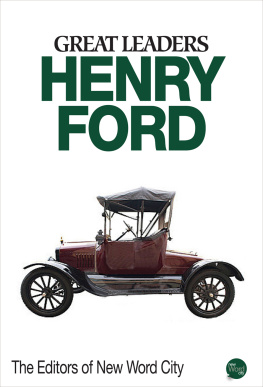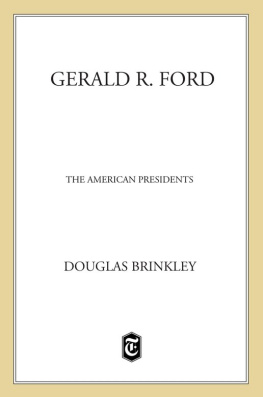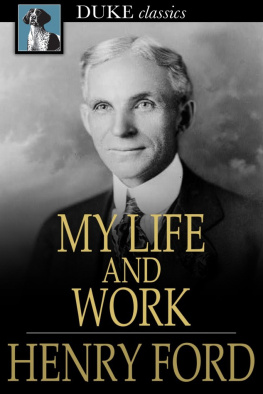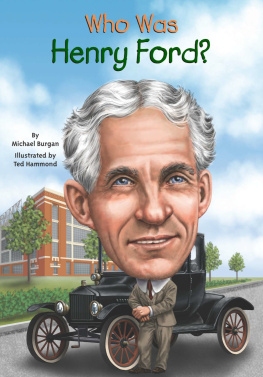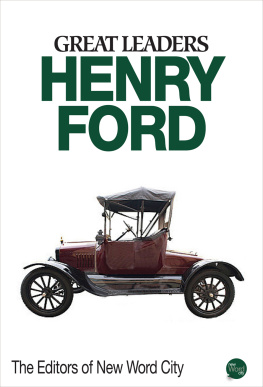More than any individual before or since, Henry Ford (18631947) is remembered as the man who took an expensive contraption of doubtful utility, a device then little more than a rich mans unreliable plaything, and brilliantly recast it as the machine that would change the world.
It has been said that all political careers end in failure, and perhaps the same is true in the highest echelons of industry.
In 1945, when Henry Ford finally relinquished control of the company he had founded, losses at the Ford Motor Company were running at an astonishing $10 million a month and the bills were piling up at such a rate that at least one department was weighing invoices rather than counting them. By this time well into his eighties, and very much against his wishes, the autocrat was finally forced out by members of his own family, his rude defenestration part stage-managed by a government concerned at the likely fate of what had become the largest industrial complex on the planet.
For all its size and Henry Fords genius as an innovator, the business was on its knees. It might even have collapsed completely had it not been for lucrative government contracts to build hundreds of thousands of aircraft, trucks and Jeeps for the long war against Germany and Japan. Given time it was to recover, but the founder was finished. Less than two years after being ousted, the man who put the world on wheels was dead, his final hours played out by the flickering light of oil lamps when a freak storm silenced the technologically advanced generators he had commissioned years before to power to his home.
The reasons behind his removal were sound, and the company might indeed have perished had its creator remained at the helm. Yet today that same bitter, cantankerous and lonely old man is lauded as one of the great pioneering spirits of the twentieth century, and widely and deservedly hailed as a rare and authentic genius of industry.
That he is takes some explaining. After all, Henry Ford did not invent the motor car: by 1896, when he had built his first primitive automobile in his backyard, the German Carl Benzs Patent-Motorwagen was already a decade old and around two dozen of them were chugging around the streets of Europe. Nor, for all the claims that continue to be made on his behalf, did Henry Ford invent the assembly line or even introduce mass production to the motor industry. That honour goes to a rival, Ransom Eli Olds, whose pioneering Oldsmobile Curved Dash first went on sale in 1901, several years before Henry Ford had anything similar available.
But far more than Olds and Benz, indeed more than any individual before or since, Henry Ford (18631947) is remembered as the man who took an expensive contraption of doubtful utility, a device then little more than a rich mans unreliable plaything, and brilliantly recast it as the machine that would change the world. This he did by almost single-handedly transforming the way motor cars were built and sold, combining the role of visionary and zealot with the determination, grit and personal energy needed to see a dream through to completion.
Because of this, and in a business with more than its fair share of brilliant innovators and powerful magnates among them Andr Citron, Vincenzo Lancia, Louis Renault, Britains William Morris and Giovanni Agnelli of Fiat Henry Ford still stands tall as the motor industrys greatest ever mogul. How great? Within a year of the Model Ts launch in 1908 the company behind it was responsible for half the cars built in continental America, and before long Henry Ford could say the same of the entire world.
Pre-Ford America had not even built its own taxi cabs (for years New Yorks fleet was imported from France, at that time the worlds largest manufacturer of cars), but by 1920 his Rouge River component plant in Detroit was its own motor city, boasting its own docks, more than 27 miles of conveyors, 16 million square feet of floor space, and a workforce 100,000 strong.
This seems to have been an industry that produced more than its fair share of egomaniacs, among them Italys inspired but flawed Enzo Ferrari, Ettore Bugatti in France, Ferdinand Porsche and Britains Walter Owen Bentley. But here, too, none of them came even close to rivalling Henry Ford. Already middle-aged when he hit the jackpot with the Model T, his forceful but contradictory character, incendiary opinions and deeply unpleasant personality came close to destroying everything that he had spent his life creating.
It was Fords personal spark of genius, however, that ignited the industry on which we have all come to depend. Following his death, no one felt it necessary to contradict the Detroit newspaper that ran the news on its front page under the banner headline, The Father of the Automobile Dies.
Henry Ford came from nowhere: a Michigan farmers son who rose from traditional, rural roots to become a multi-billionaire. (Historic wealth comparisons are notoriously difficult to calculate, but at his peak he might have been worth in excess of $150 billion at present values.) He was also a ruthlessly single-minded autocrat who became a genuinely popular folk hero, and an ardent pacifist who went on to inspire Adolf Hitler and Joseph Stalin (neither of them in a good way). Here was a chief who voluntarily chose to pay factory workers twice what his competitors were paying, yet who went on to wage a bitter, personal war against trades unions; a man who genuinely wished to improve the lot of the working poor, yet committed deliberate and repeated abuses of power, and employed thugs to enforce his oppressive rules.
Of course, only the most nave observer would expect an industrialist operating on such a scale to be nice, but Henry Ford was worse than most. Early photographs show him with a wry little half-smile and a positive twinkle in his eye, looking every bit the benign, avuncular benefactor he thought he was. But the reality is that he paid his men double knowing this was the only way they could afford to buy the cars he wanted to sell to them. It worked, too, so well that Henry Ford got back much of the money almost immediately, which he then used to bankroll his own, private newspaper.
Published with the express purpose of campaigning against Jews, whom he blamed for all manner of world ills including female fashions and jazz, news of the The Dearborn Independent travelled far and wide. Today Ford enjoys the dubious distinction of being the only American citizen mentioned by name in Hitlers autobiographical Mein Kampf.
That we forgive him for this, or at least turn a blind eye to it, is entirely down to one car, the aforementioned Model T. The celebrated Tin Lizzie the nickname possibly derived from a racing version, which, though battered, was victorious is the car that motorised America. A well-engineered, soundly built utilitarian machine that ordinary US citizens could afford to buy and run, it was also the best possible advertisement for Fords company and one which helped propagate his radical production-line techniques. It was a creation whose underlying philosophy can be said to have paved the way for the machine age, to have kick-started a second industrial revolution.
Among customers in Americas rural hinterland the Model T was widely admired because it was rugged, straightforward to repair and easier to drive than most of its rivals. Thanks to what now looks like a uniquely thoughtful design, it turned out to be largely free of the quirks and pitfalls that early motorists had hitherto considered inevitable. It was also versatile, so that tough little truck and bus variants soon joined the many car and pick-up versions plying the dusty roads of early twentieth-century America.
By 1914, Ford was building so many Model Ts that his company had become the largest in America. At its peak, one car came off the production line every ten seconds. Such was its ubiquity that years later, in

